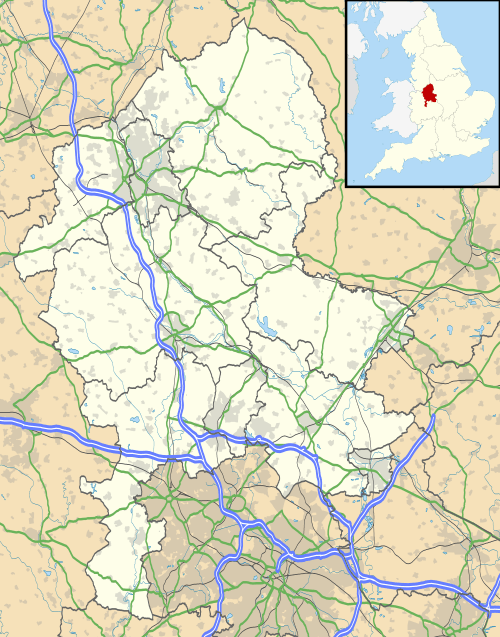Guildhall, Lichfield
The Guildhall is a historic building in Bore Street in Lichfield, Staffordshire in the United Kingdom. The Guildhall is a Grade II listed building.[1]
| Lichfield Guildhall | |
|---|---|
 | |
| Location | Lichfield, Staffordshire |
| Coordinates | 52.683080°N 1.827182°W |
| Built | 1848 |
| Architect | Joseph Potter Jnr |
| Architectural style(s) | Gothic-style |
Listed Building – Grade II | |
| Designated | 6 March 1970 |
| Reference no. | 1187740 |
 Location of Lichfield Guildhall in Staffordshire | |
History
The Guildhall takes its name from the ancient Guild of St Mary and St John the Baptist, whose hall stood from very early times on this site. It is not known when the first Guildhall was erected but it is believed to have been around 1387, when King Richard II confirmed the incorporation of the Guild.[2] The old prison for felons and debtors is at the rear of the building and has been in existence since 1553. From here have issued various convicts condemned to be publicly hanged at the gallows. The guildhall was rebuilt in 1707 and extended in 1741.[1]
Most of the present ground floor, and the smaller rooms at first and second floor level at the rear of the building date from the early 18th century. A century later the building was once more in a very poor state of repair and, in 1844 the Conduit Lands Trust agreed to provide £2,500 and constructed the building. The hall and frontage was rebuilt between 1846 and 1848 by Joseph Potter Jnr.[1] It is these works which created the gothic-style frontage to Bore Street and the panelled main hall on the first floor. This room is 87 ft long by 25 ft wide and, with its high pitched roof and hammer beams, has a fine medieval appearance. At the north end there is a large stone tracery stained-glass window. This was originally in the north transept of the Cathedral and was transferred to the Guildhall in 1891.[1]
Major refurbishment and repair works have recently been completed to restore this building, and to provide improved facilities for its use by the public. The main hall and various smaller rooms are hired out for public meetings, dances and as function rooms, and there is a programme of arts events and concerts run by the Lichfield District Arts Association. Civil marriages can take place at the Guildhall. The Guildhall is used for Council meetings and civic events including the ancient Court of Arraye and St George's Court.[3]
References
- Historic England. "Guildhall, Lichfield (1187740)". National Heritage List for England. Retrieved 26 August 2019.
- Greenslade, M W (1990). "'Lichfield: Guilds', in A History of the County of Stafford: Volume 14, Lichfield". London: British History Online. pp. 131–134. Retrieved 26 August 2019.
- "Traditional St George's Court returning to the Lichfield Guildhall". Lichfield Live. 18 April 2014. Retrieved 26 August 2019.